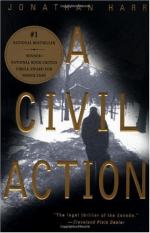|
This section contains 454 words (approx. 2 pages at 400 words per page) |

|
A Civil Action Summary & Study Guide Description
A Civil Action Summary & Study Guide includes comprehensive information and analysis to help you understand the book. This study guide contains the following sections:
This detailed literature summary also contains Topics for Discussion and a Free Quiz on A Civil Action by Jonathan Harr.
Children in Woburn, Massachusetts are getting sick - terribly sick. When Anne Anderson discovers that her three-year old son has leukemia, she embarks on a quest for its cause, only to discover what constitutes a childhood leukemia cluster in her small town just north of Boston. One common environmental factor for all of these children is the water, pumped from Wells G and H, which has been a subject of complaint and controversy for some time, due to foul odor, taste, and color. Anne's research eventually evolves into a civil suit, on the part of many affected families, against two large corporations, Beatrice Foods and Grace Chemical, with the contention that they have contaminated the wells with a carcinogen, specifically trichloroethylene (TCE).
Author Jonathan Harr traces the course of this civil action through the history of corporate dumping activities, backgrounds of all parties, the discovery and deposition phases, the trial itself, the verdict and, ultimately, settlement negotiations and appeals. Most of the story is recounted through the eyes of Jan Schlichtmann, attorney for the plaintiffs. He chronicles his time-consuming, laborious and horribly expensive preparation for what he believes will be a landmark case, sending a message to corporate boardrooms and netting the plaintiffs and himself huge compensatory and punitive damage awards. To this end, Schlichtmann spends over two million dollars for medical and geological reports and documents, employing experts at each phase of trial preparation. Defense lawyers, however, are focused on maneuvers to detract and ultimately thwart the proceedings, often successfully doing so.
In the end, Schlichtmann must accept a less-than-attractive settlement from Grace Chemical, in order to provide the families some compensation and to repay creditors, netting himself a mere thirty thousand dollars. Attempts to appeal the verdict which vindicated Beatrice fail, even though Schlichtmann has uncovered new evidence implicating Beatrice in the contamination. Ultimately, the case fails to become the landmark decision for which everyone had hoped, and Schlichtmann is forced into bankruptcy, contemplating the termination of both his career and his life.
This true account of a community's attempt to hold corporations liable for their actions has much to teach about the judicial process itself. The reader will be amazed to discover the amount of preparation necessary for personal injury litigation and the tremendous cost of such civil suits. As well, the judicial process itself is often portrayed as skewed in favor of corporations, which have unlimited financial resources and high-priced, highly-experienced litigation attorneys. Indeed, it is easy to share Schlichtmann's frustration and anger as he wends his way through the continual roadblocks of a legal system that appears to be designed for the rich, the connected, and the experienced, rather than for the purpose of truth-seeking.
Read more from the Study Guide
|
This section contains 454 words (approx. 2 pages at 400 words per page) |

|



